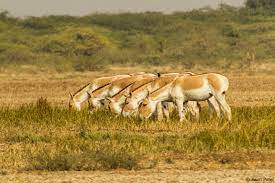The Indian wild ass is a unique and fascinating animal that can be found in the arid regions of India. In this article, we will discuss the characteristics, habitat, behavior, and conservation status of this magnificent creature.

Table of Contents
Characteristics of Indian Wild Ass
It is a member of the horse family and is similar in appearance to a donkey. However, it has a sleeker body and longer legs than its domesticated cousin. It has a sandy brown coat with a white belly and a short mane. It stands about 4 feet tall at the shoulder and can weigh up to 550 pounds.
Habitat of Indian Wild Ass
It is found in the dry and arid regions of India, specifically in the Rann of Kutch in Gujarat, which is the largest salt desert in the world. The Rann of Kutch is a harsh and unforgiving environment, with temperatures that can reach up to 120°F and very little water. Despite these harsh conditions, the it has adapted to thrive in this unique ecosystem.
Behavior
It ass is a social animal and can be found in herds of up to 100 individuals. They are active during the day and rest in the shade during the hottest part of the day. They are herbivores and mainly feed on grasses, shrubs, and other vegetation found in their habitat. The Indian wild ass is a fast runner and can reach speeds of up to 50 miles per hour.
Conservation Status of Indian Wild Ass
It is listed as endangered by the International Union for Conservation of Nature (IUCN) due to habitat loss, hunting, and competition with domesticated livestock for resources. In recent years, efforts have been made to protect this species, including the creation of wildlife sanctuaries and conservation programs aimed at increasing their population.
Conclusion
It is a unique and fascinating animal that has adapted to survive in the harsh and arid environment of the Rann of Kutch. While it is endangered, efforts are being made to protect this species and ensure its survival for future generations. As humans, it is our responsibility to protect and conserve our planet’s biodiversity, including this animal.
Important Links